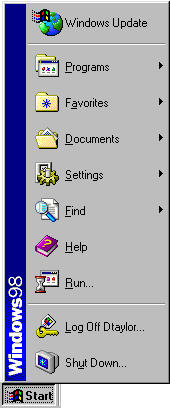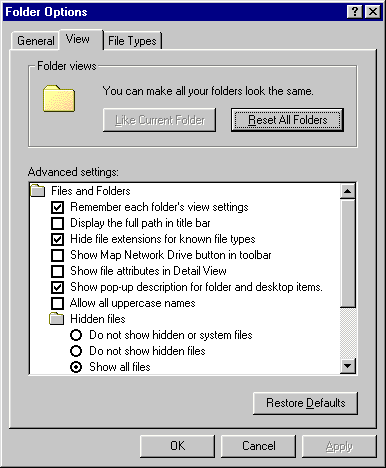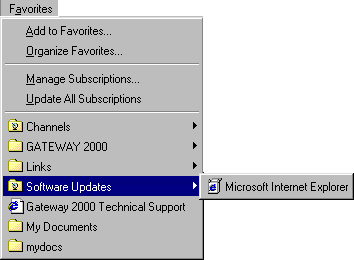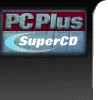| Start Menu and taskbar  The Windows 95 Start menu has become something
of a modern day icon. It baffled novices with the inclusion of Shut Down - "You mean
I go to the Start menu to stop the computer?" - but more importantly it gave users
easy access to applications and files as one of the core improvements offered by Windows
95. There are two sets of improvements made to this part of the system, the first are ones
that came with IE4 and the second are new tweaks added by Windows 98. The Windows 95 Start menu has become something
of a modern day icon. It baffled novices with the inclusion of Shut Down - "You mean
I go to the Start menu to stop the computer?" - but more importantly it gave users
easy access to applications and files as one of the core improvements offered by Windows
95. There are two sets of improvements made to this part of the system, the first are ones
that came with IE4 and the second are new tweaks added by Windows 98.
 IE4 added new bars to the main task bar at the bottom of the screen, and
allowed users to move and customise the new Address,
Quick Launch and Desktop
toolbars. These provide single-click access to programs, documents, folders and other
objects on your local system and the Internet. IE4 added one special new toolbar, the Links bar, which is similar to the Quick Launch bar but can
also appear as an integral part of the IE4 browser/explorer window. You are not limited to
the supplied toolbars and can create your own too. IE4 added new bars to the main task bar at the bottom of the screen, and
allowed users to move and customise the new Address,
Quick Launch and Desktop
toolbars. These provide single-click access to programs, documents, folders and other
objects on your local system and the Internet. IE4 added one special new toolbar, the Links bar, which is similar to the Quick Launch bar but can
also appear as an integral part of the IE4 browser/explorer window. You are not limited to
the supplied toolbars and can create your own too.
 IE4 added a Favorites item, which opens
cascading menus into your IE 4 Favorites folders, and updated the Find
menu with more enhanced options for quicker local drive searching. An additional tweak
is the ability to re-order Start menu items by dragging and
dropping. IE4 added a Favorites item, which opens
cascading menus into your IE 4 Favorites folders, and updated the Find
menu with more enhanced options for quicker local drive searching. An additional tweak
is the ability to re-order Start menu items by dragging and
dropping.
 It
changed the name of the Taskbar menu item in the Settings menu to Taskbar & Start menu
but did not and still does not actually give you access to all the options for the
Taskbar. This menu item simply opens the properties for the taskbar and the Start menu,
the same as right clicking on the taskbar and selecting Properties in Windows 95. In order
to enable/disable the toolbars in the taskbar you
have to right click in the toolbar and choose the cascading menu. Here you can tick/untick
the toolbars, but they are not included in the taskbar properties opened from the Settings
menu. It
changed the name of the Taskbar menu item in the Settings menu to Taskbar & Start menu
but did not and still does not actually give you access to all the options for the
Taskbar. This menu item simply opens the properties for the taskbar and the Start menu,
the same as right clicking on the taskbar and selecting Properties in Windows 95. In order
to enable/disable the toolbars in the taskbar you
have to right click in the toolbar and choose the cascading menu. Here you can tick/untick
the toolbars, but they are not included in the taskbar properties opened from the Settings
menu.
 |
Folder Options However, it does also add in the Folder Options item that opens a dialog in
which you can choose the Classic style of UI, which means that Windows 98 looks very much
like Windows 95. The alternative is the Web style that IE4 wanted people to favour,
created by Microsoft after tests with members of the public who found the idea of single
clicking easier than double clicking. Essentially this makes much of the interface behave
like a web page (not surprising as the file windows are actually HTML pages now) so that
the pointer turns to a hand if it hovers over a folder or file for you to click on -
reminding you, in case you didn't know, that you can open it. As with hyperlinks in HTML
pages the web view means that you only single click on the folder/link to open it. It
represents a shift in the Windows metaphor towards the HTML view, but has not proved
popular with many users in the real world and was therefore removed from being the default
option in both IE4 and Windows 98. |
 |
You can choose a hybrid of these by selecting the
third option, Custom. This has a Settings button that opens a second dialog. Within this
you can choose whether to see folders that have HTML content (which is all of them as
Windows 98 uses a default one for windows that don't have a custom one). You can enable
the Active Desktop, change between single and double clicking and choose between opening
folders in the same window or opening a new window. See also Customising your folder view backdrop |
 |
The View tab allows you to change the details of
general folder views, like whether to see hidden files or not - IE4 does this very well by
showing hidden files greyed out so they are visible and accessible, but you know instantly
that they are "hidden". This folder option dialog is also available from the
browser/explorer menu item View\Folder Options. Opening it from there allows you to change
the view options for that single folder. Wherever you open it from, you can make changes
to the view options and then apply them to all folders so they are the default options by
clicking on the Like Current Folder button. You can reset the choices to the system
defaults by clicking on the Reset All Folders button. |
 |
The last tab on the Folder Options dialog allows you
to change the File Types, which are the associations made between data files and
applications. For example a Word file appears with a Word icon because the .Doc file
format is associated with Word. It is in this dialog that you can change those
associations so that different applications open a given file type. This is the same
concept as is used under Windows 95, but IE4 added a new look to the interface and added
in a few options. Only use this option if you are familiar with the way Windows
associations work. |
The last addition to the Settings menu is the Active Desktop item.
This allows you to quickly change your Active Desktop settings so that it displays the
HTML content and also opens the Web tab on the Display settings from Control
Panel.
Re-ordering Start menu items
 The Start menu now has drag and drop capability, so you can pick up an icon
from the Desktop and move it over the Start button to open the Start menu, then drag it to
wherever you want and drop it. Whether the file you are dragging is Shortcut or a real
file, a shortcut to it will be created automatically. You can place the item wherever you
want in the Start menu and it will remain exactly there. By extension you can also pick up
Shortcuts that already exist in the Start menu and drag them around it to different places
or even back off the Start menu to create a Shortcut off the Start menu from a Shortcut
that is on it. The Programs menu item and sub menus ar no longer restricted to a
folder/item order. They can be dragged into the order you want, so if you want a
particular folder or file at the top of the Programs menu, move it there by dragging and
releasing. The items are also now available as right clicks so you can delete them easily
too without having to open the Settings for the Start menu and
going to the Advanced tab as you do under Windows 95. This is made even more useful if you
use the Target menu addition available from the PowerToys enhancements as you can
quickly get to the real file or even operate on the real file directly from the Start
menu. The Start menu now has drag and drop capability, so you can pick up an icon
from the Desktop and move it over the Start button to open the Start menu, then drag it to
wherever you want and drop it. Whether the file you are dragging is Shortcut or a real
file, a shortcut to it will be created automatically. You can place the item wherever you
want in the Start menu and it will remain exactly there. By extension you can also pick up
Shortcuts that already exist in the Start menu and drag them around it to different places
or even back off the Start menu to create a Shortcut off the Start menu from a Shortcut
that is on it. The Programs menu item and sub menus ar no longer restricted to a
folder/item order. They can be dragged into the order you want, so if you want a
particular folder or file at the top of the Programs menu, move it there by dragging and
releasing. The items are also now available as right clicks so you can delete them easily
too without having to open the Settings for the Start menu and
going to the Advanced tab as you do under Windows 95. This is made even more useful if you
use the Target menu addition available from the PowerToys enhancements as you can
quickly get to the real file or even operate on the real file directly from the Start
menu.
Windows Update
  The Windows Update item in the Start menu is similar to the Find
on the Internet addition to the Find menu, except it has the potential to be one of
the most useful new features. Like Find... it is simply a link to an HTML page hosted on
Microsoft's site. The Windows Update item in the Start menu is similar to the Find
on the Internet addition to the Find menu, except it has the potential to be one of
the most useful new features. Like Find... it is simply a link to an HTML page hosted on
Microsoft's site. However, like the addition of Internet Explorer 4 optional
extras by the Outlook 98 program that is on this SuperCD, it
asks if you are happy to let your PC send information about the hardware and software on
your PC. As long as you are, Windows Update can check the list against its own database of
drivers and patches to ensure that you are running all the latest versions. The system is
not fully working yet and more software is going to have to be added before it can be
considered anywhere near useful or complete, but when that happens you will no longer have
to go searching for updates to your display drivers or for that 0.01 upgrade to your image
editor that fixes that annoying bug, because you'll be able to just tell your PC to update
itself. The Windows Update is really a completed version of the IE4 Software updater that
enabled it to patch itself, although Microsoft has yet to release an update that way. One
other thing is sure and that's that Microsoft asking people to send details of their hard
drive willingly is going to have the conspiracy theorists up in arms about possible
privacy breaches. However, like the addition of Internet Explorer 4 optional
extras by the Outlook 98 program that is on this SuperCD, it
asks if you are happy to let your PC send information about the hardware and software on
your PC. As long as you are, Windows Update can check the list against its own database of
drivers and patches to ensure that you are running all the latest versions. The system is
not fully working yet and more software is going to have to be added before it can be
considered anywhere near useful or complete, but when that happens you will no longer have
to go searching for updates to your display drivers or for that 0.01 upgrade to your image
editor that fixes that annoying bug, because you'll be able to just tell your PC to update
itself. The Windows Update is really a completed version of the IE4 Software updater that
enabled it to patch itself, although Microsoft has yet to release an update that way. One
other thing is sure and that's that Microsoft asking people to send details of their hard
drive willingly is going to have the conspiracy theorists up in arms about possible
privacy breaches.
Help
  The Windows help file has been re-created in HTML and a
customised browser is now used to give you access to all the topics. This change is in
line with Microsoft's overall strategy to move the OS and programs towards a WWW-type
integration where users only have to get used to one type of interface to access any
information, be it files, text, local or web based. In functionality the system remains
similar with Contents, Index and Search (type a topic and press return and a list of
relevant topics are displayed in the topic pane), though it no longer needs to create the
initial database as in Windows 95. You choose the topic you are interested in from the
left pane by double clicking on one and it is displayed in the right pane. Related Topics
are still available as links at the bottom of the HTML page. The Windows help file has been re-created in HTML and a
customised browser is now used to give you access to all the topics. This change is in
line with Microsoft's overall strategy to move the OS and programs towards a WWW-type
integration where users only have to get used to one type of interface to access any
information, be it files, text, local or web based. In functionality the system remains
similar with Contents, Index and Search (type a topic and press return and a list of
relevant topics are displayed in the topic pane), though it no longer needs to create the
initial database as in Windows 95. You choose the topic you are interested in from the
left pane by double clicking on one and it is displayed in the right pane. Related Topics
are still available as links at the bottom of the HTML page.
A new feature in this new interface is the Web Help button (see
right) which will take you on-line to search for your topic in the Microsoft Knowledge
base. This is one reason why HTML has been chosen so that users can get access to up to
date information or topics that aren't included in the Help file in a seamless manner (as
long as they have WWW access, of course). In fact the link simply opens a browser with
parameters from a Javascript HTML page.
Animation
 Just in case you hadn't heard about this, one of the most obvious visible
changes is in the way Windows menus, including the Start menu and right button menus now
appear by scrolling out. Sub menus also do this. If you want to disable this feature you
can do so in the Effects tab in the Display Control Panel. Just in case you hadn't heard about this, one of the most obvious visible
changes is in the way Windows menus, including the Start menu and right button menus now
appear by scrolling out. Sub menus also do this. If you want to disable this feature you
can do so in the Effects tab in the Display Control Panel.
Shut Down
 One of the invisible improvements to Windows 98 is also the
speed of Shut Down. If you select Shut Down from the menu, you now get an additional
option for Stand By. This actually puts the machine into Sleep mode in compliance with the
OnNow initiative. See also Accelerated boot time One of the invisible improvements to Windows 98 is also the
speed of Shut Down. If you select Shut Down from the menu, you now get an additional
option for Stand By. This actually puts the machine into Sleep mode in compliance with the
OnNow initiative. See also Accelerated boot time
|



